Medinilla cuttings?
Hi all, is it possible to strike cuttings from a medinilla and if so, how to go about it? It's flowering at the moment.
Many thanks for any advice,
Josie.
Comments (36)
Related Professionals
Euless Architects & Building Designers · Universal City Architects & Building Designers · Winchester Architects & Building Designers · Gallatin General Contractors · Jefferson Valley-Yorktown General Contractors · Lighthouse Point General Contractors · Merritt Island General Contractors · Mira Loma General Contractors · Texas City General Contractors · Travilah General Contractors · Mansfield Interior Designers & Decorators · Shorewood Interior Designers & Decorators · 70037 Landscape Architects & Landscape Designers · Erie Landscape Architects & Landscape Designers · Glen Ellyn Landscape Architects & Landscape Designersrichardqld
20 years agoI saw this plant for the first time recently growing in the car park of a bayside nursery.It looked awesome ,it was huge,growing in an old tree stump.Have you found it an easy plant to grow?,how thirsty is it?
cheers.CoralCoast_Tropicals
20 years agoRichard,
They are very easy to grow in a semi shaded garden position and as for water mine get watered once a week (If they are lucky).Josie,
I find that they are easy to propagate by layering or marcotting.Andrew.
billabonggardens
19 years agoIts a native of the Philappiens and grows naturally in hollow logs there up to about 10 feet usually.
I picked up one and planted it in a log over a year ago and its doing greatalisonoz_gw
19 years agoSeed also. After flowering, take the plumpest and most purple berries and squeeze out the contents - lots of fine seed that will germinate if you have the patience (I didn't quite make it LOL)
aroideana
19 years agoThere are several spp. in cultivation here in Qld. now .
a lovely dwarf one is my favourite . saw boxes of cutings being struck at a mates place .john_dr
19 years agoI purchased a medinilla from our local Bunnings,Gosford. They didn't know what it was. The plant flowered in June and has survived the winter with no ill effect. I am interested to learn that the plant is an epiphyte as I grow Cattleya and other orchids on the tree ferns in my garden.
I must try to take a cutting and grow it in an old tree stump or similar.zeta9
19 years agoAlthough some of them are epiphytes, they don't take too well to hot and dry conditions. They are mountain plants that grow in constant cool and moist conditions (M magnifica)
Tamoure
19 years agoRaymondo,
I have heard of using honey before for its antifungal properties. Does it really work?
TamoureIan_Wintle
19 years agoThe old King Country Nursery at Thornlands has reopened and are looking to get rid of lots of old stock. They have lots of medinillas in pots, healthy looking for approx $5 or less.
I have bought a few myself.
Ianflorial
19 years agojosiegirl,as yours is flowering and in the brisbane climate, can you advise your plants situation. mine's still in a pot and NOT flowering. i didnt plant it out because i thought the winter nights might be too cold outdoors,and moved it under shelter over winter, but am thinking to give planting a try.i've had it 2 years.-florial
hanninkj
19 years agoI have an article in dutch but I have two pictures of a cutting. Cuttings are very easy.
Here is a link that might be useful: Medinilla magnifica
deniseks
13 years agodo they require a tropical climate or a cool. would love to try in adelaid. temperate climate, or would they grow in a glass house.
puglvr1
6 years agoDoes any one here still have their Medinilla magnifica? How do you grow yours? Any growing tips and advise is appreciated...
Vera Lynn
6 years agoEach time I see a Medinilla variety that I do not already have, I buy it. I now have a delightfull collection ranging from dwarf varieties in hanging baskets to the striking and delightful Medinilla magnifica and numerous others in between. I grow these on the margins of a rainforest which over 30 years I have established on a 1/4 hectare of land immediately outside my kitchen window.
I live on the top of a gravelly hill in very poor land north of Raymond Terrace in NSW. My Medinilla plants are growing in the native soil and are moderately well mulched with whatever is available, usually just decaying eucalypt leaves swept from the paths. They receive daily water from a dripper system during summer but at other times fend for themselves. When I remember to fertilise, which is neither regularly nor often, I give them a handsome dose of whatever I'm working with. This is often Camellia fertilizer but they do not appear to be fussy and sometimes get Multigrow or Grower 12. Sometimes even fowl manure in small doses. Being on the rainforest margins they get dappled sunlight both morning and evening, but they do get the full sun for an hour or two in the middle of the day. Because they are separated from my window by only a 2 metre path, there is a wind/draft tunnel effect passing down the path which can lead to some leaf margin scortching. As the reader can I am sure imagine,
I have many plant varieties and I cannot devote large amounts of time or resources to any particular group. Medinilla I have found to be a reliable and easily maintained group here on the NSW mid coast.
kitskitchen
4 years agoCan anyone tell me what's causing this? I planted the medinilla about a year ago in a pot with gravel in the bottom and then soil. The pot sits in the middle of a small water container with waterlilies, outdoors but in a protected spot. My idea was that the soil would be above the water, but the gravel in the pot would be at the level of the water in the larger container. I thought this might be a good way to keep the humidity up without putting the roots in water. But it the plant wanted to reach water, it might send a root down through the gravel. It did quite well last year, with big flowers, but started to get badly drying leaves as you can see in this photo, and it lost a few big leaves. It made it through winter here in Sydney - and is now trying to grow and producing flower buds, but it's also losing leaves again, pretty badly. Too much water? Not enough? Too low humidity (we're in drought), Needs fertiliser? Should have been repotted in orchid soil, not the light potting soil I used?? I wish I could tell. Good advise would be wonderful. Thanks for any help.
Kit
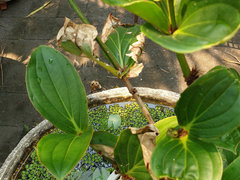
Vera Lynn
4 years agoKit,
I am almost certain that your issue is drying wind/breeze. That is a common problem particularly during periods such as we have recently experienced. Dry patches such as those displayed can be caused by just a few things and it's fairly easy to differentiate between them.
The first and most concerning is fertiliser burn. This comes in either of two forms. In the first, the leaves turn grey very rapidly, often mushy at first and then begin to dry out. This usually takes place rapidly and within a week or so of feeding. There is little you can do about that form of burning except to flood the plant with running water in an effort to flush out the excess nitrogen. Sometimes it works.
The second form of fertiliser burning is much slower acting. The excess nutrients carries in the sap flow build up in the leaves and because the edge of the leaves dries out first, the leaf margins begin to dry out leaving the leaf margins dead and crispy. In this case the sap flow varies with the available moisture and so it flows then stops then starts again when the moisture levels increase again. The result is that the leaf margins dry out bit by bit and lines appear between the dry patches just as lines appear where the waves reach their maximum at the beach. Often there is a slight variation in the colour between adjacent strips.
The photograph is a bit small for me to be certain that no such lines and variations appear on your leaves, but I can't see them.
Wind scorching can be similar but but lack the differentiation lines and colour variations.
Sun burning is usually more patchy resulting in scorched patches that commonly are not necessarily at the leaf margins. But of course that can be. It just depends on where the leaf is most exposed.
Commonly, and I suspect in your case (and some of my own) the problem is a combination of both wind stress and and heat stress and is not surprising having regard to our recent weather. But fear not. The damage on your plant is not excessive and the plant should soon burst out in new growth from almost every leaf node. You could cut off the damaged leaves or half a leaf if it offends you but don't worry all will be well.
Excess water usually leads to mushy leaf margins which your plant does not have.
There are a few other biological causes of leaf browning associated with particular plant species but it is very unlikely your plant is subject to them.
There are also other types of damage which can result from nutrient deficiencies and excesses but these are not apparent in your leaf samples. Salt burning is very similar to the fertiliser burn described above.
In a final comment, I suggest that you do not rely on bottom watering alone. The gravel may not promote capillary reaction to keep the above compost moist. In some cases this results in desiccation and loss of roots in the compost above the water line.
Medinilla are not particularly fussy about the compost provided it is free draining yet has sufficient moisture holding capacity in the organic components to maintain the plant. Medinilla are also prone ot falling over so don't be concerned about that, they will lean on the ground and just grow on and up.
That was a bit rambling but I hope that helps. Feel free to get back to me if I can help further. And don't panic!
Merry Christmas.kitskitchen
4 years agoHi Vera Lynn,
That is a HUGE help, and very thoughtful of you. "Ramble" on! I just got home and am going to go look more carefully at the leaves.
OK, I think you are probably correct about the wind and heat stress, and I really appreciate your suggestions that I shouldn't panic! A bit more information, if I may ask:
Here's a close up of a pair of badly damaged leaves. Maybe that will tell you more? Is there more I should be doing?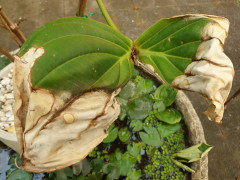
At the bottom of the picture, you may notice pair of medinilla leaves in the water (and another pair shrivelled up on the edge - Wind or possums knocked them to the ground, and I just found them and put them back in. Don't think possums are a problem here. The eat practically any garden plant, but they didn't eat these leaves, and I think both pairs feel off by themselves - or because of causes unknown. The leaves fell off the plant young and in good condition. I stuck them in the water and wondered if (1) would they root! and (2) is this a normal way for a medinilla to start a new plant? I'll attach a close up of the one that has been in the pond and is not wilted.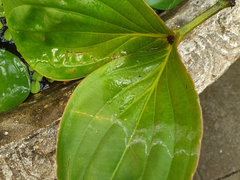
The white salty-looking line is just from being half in the water. There is some fertiliser in the water from the waterlilies, but not enough to kill the small white cloud fish also in there to eat mosquito larvae. We are near the Middle Harbour, but not hanging over it, and none of my other plants show anything like salt damage that I can see. Could even be ash from the fires this week.
Your advice on watering is timely. I have watered the plant from above, but not regularly. Maybe it's been too dry? Also, I was uncertain about fertilising it, and there was some fertiliser in the potting soil, so I didn't add more. Maybe I've been starving the plant of water and nutrition?
Your place sounds quite wonderful. I can hardly imagine a collection of different medinillas. How fabulous, and how clever of you to start such a thing - and keep it going. I've been a gardener to varying degrees all my life, but a lot of moving around, both for work and in my choice of where to live at different times mean that I haven't developed one good garden. Maybe I'll manage yet, but this house has shade (nice!), shallow soil (rock!) and possums, so gardening here can be a real challenge.
Merry Christmas to you (my house guests of this week just left).Kit
Vera Lynn
4 years agoKit,
Thanks for posting the larger image. I still see no evidence of fertiliser burn on the leaves. As I mentioned earlier, fertiliser burn usually first appears at the leaf margins; starting at the tip and gradually spreading around the edges of the leaf. It also commonly leaves characteristic "tide marks" as internal leaf moisture fluctuates with the weather. I see none of those characteristics in your images. What I see is not marginal scorching but broad areas of desiccation, some at the leaf tip but other isolated broad areas further from the tip . These are more suggestive of environmental issues such as lack of humidity possibly caused by drying breezes.
Medinilla are not regular garden plants. They mostly grow as epiphites attached to the trunks or branches of trees in the humid tropical rainforest. Their roots may gather nutriments and even some moisture from litter caught in the forks of trees or behind lichen and other plants clinging to the tree trunks. But most of their moisture is absorbed from the moist atmosphere of the rainforest. They are not accustomed to dry air and they suffer greatly when exposed to it.
The fresh leaves which have fallen to the pond have probably suffered the same fate, falling from the plant when the sheer point at which they are attached to the stem has dried out. They have flaked off if you like.
The fallen leaved will not take root. They are usually produced from cuttings. After flowering the [plant should produce a spurt of new growth and once this begins to harden off and will not redily snap when gently bent, it is time to take the cuttings. Some varieties strike roots fairly easily but others such as M. magnifica are much more reluctant. They are also reproduced from "tissue culture" by specialist nurseries. T here are some very large production nurseries in Canada producing colour variations with great promise.
My suggestion is that you try to increase the humidity around the plant and keep it out of the wind. Bunching other plants around it is often helpful in maintaining local humidity. If you keep in mind the warm humid jungle or rainforest and strive to get as close as you can to that. There are many things you can do. But taking it inside should be a last resort. Even when the humidity outside is 80%, inside it may be as low as 10%. Not so good even in the laundry.
I hope that helps
RegardsV
kitskitchen
4 years agoHi Vera Lee,
Yes, all that you have written is very helpful indeed. The plant is pretty well out of the wind - we're on a slope, and it's in a lower garden area. The humidity isn't much in these droughty times, 22% by one count today.
Because of your advice, I started watering the plant from above - with a watering can as we are on restrictions now - wetting all the leaves and also the soil. Previously, I was afraid of making the soil too damp and encouraging molds, but now I think it must have been too dry, and if I overdo it, any excess should drain into the water lily container below.
It's not ideal, and I've been thinking about how to increase the number of plants around this one Medinilla. Possibly, I could get 3 or 4 wire flower pot holders and some small pots of annuals, and hang them from the edge of the pot that the Medinilla is in - over the water and the waterlilies. The waterlilies are having a tough time - they are fighting algae, and possums have discovered them. I might have to turn the entire thing into a planter instead of an attempted little water garden. Any further advice you care to give would be most welcome.
An aside: a couple of years ago, I brought some pink-blooming waterlilies down from my sister-in-law's farm pond in QLD. They did very well, bloomed repeatedly and filled the water (no pot in the middle then) until one evening, just at dusk, I saw what looked like a possum tea-party. There were four of them, sitting around the edge of the big concrete pot with water, with their tails hanging over the edge behind them as they ate ALL of the water lilies. It's possible those waterlilies would have been invasive - I don't know, but there was no natural fresh water body near us for quite a way so I wasn't worried, but once the possums got to them, it was the end of them anyway.
So, we have another hot smoke-laden day today, which is disturbing. I hope you are well away from fires and from smoke.
Best,Kit
kitskitchen
4 years agoHi Vera Lee,
Just an update, in case you are curious. I certainly appreciated - and still appreciate - your assistance in learning about the needs of Medinillas. With our funny summer, the dry and windy conditions, even in what I consider a sheltered area of our little garden, seemed to be just too droughty, even with the plant directly over a collection of water lilies in a large container/pot. It kept on losing leaves. So, I moved the plant, in its pot, around to the back garden where there is a small fish pond. Broke the pot in doing this - turned out to be a rather flimsy fibreglass-looking thing. So, repotted, in a heavier, glazed ceramic pot with only orchid mix after learning from you that it is an epiphyte, and set it a bit in the water, but mostly out, over the fish pond. It gets better indirect light, more humidity and is better sheltered from the wind.
Of course, then the heavy rains came and the fires are out and the drought broke (hurray!).
The plant still lost the edges of some of its leaves. But now, a couple months on, it's suddenly starting to put out new leaves, and I hope it will do well. I'm slightly worried about the bottom of the pot being in the water, but figured that it helps the humidity, and the plant probably doesn't have deep roots, and there's enough room in the pot for it to have roots out of the water.
So, things are looking up a bit. Will attach a photo. Yes, new leaves, old dry leaf, leaves of bat plant at the side (also over the water and very happy) and a water dragon in the background.
I appreciate any advice you still care to give.
I hope you and your garden of Medinillas are both doing very well after this unusually tough and rather strange summer.
Best regards,Kit
Vera Lynn
4 years agoHi Kit,
I'm pleased to know that things are looking up. Autumn is a good time for Medinillas. They begin to put on new growth and they come into their peak of flowering. In short, they look their best.
When it comes to potting medium I prefer a quite open mix containing sufficient organic matter to retain adequate moisture and to hold nutrients (good cation exchange capacity) and yet to allow all surplus water to run straight through. When I water,I like to see the water running out the bottom of the pot almost instantaneously. There should be no pooling on top of the potting medium.
I have some potted Medinilla doing quite well in Searles "Cymbidium & Bromeliad" compost purchased in 30 litre bags at many nurseries. It is an open gritty mix containing both fine and coarse pine bark as well as crushed ash. It drains quite well, offers good support and also contains a low level of slow release fertilizer. But more will be needed. You may need to be careful though, not to wash surplus salts (fertilizers) into the pool as this will encourage the proliferation of algae in the pool.
If you're having trouble finding an open mix, you might consider using a standard potting mix but incorporating very coarse coconut fibre or chips. Bunnings sell a range of compressed 'Coir' coconut fibre in blocks which expand to 30 litres and cost about $16.00. Choose the very coarsest of the range and add sufficient to the potting medium to obtain the desired drainage.
The blocks are located in the gardening section within the building not in the outdoor section.
The images below will provide some idea of the network of roots on a Medinilla myriantha growing in a 25 cm container.
Thank you again for the update.Keep dipping those thumbs in the green dye.
Regards,
Vera
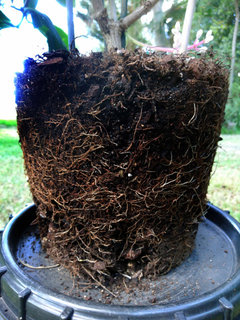

kitskitchen
4 years agoHi Vera,
Thank you for keeping in touch, being encouraging and sending more photos, which look very good and give me hope (and some envy!). Thanks also for all the info on potting mediums. I haven't seen the Searles "Cymbidium & Bromeliad" compost that you mentioned, but I'll keep an eye out for it. The "orchid mix" that I got is definitely open and well-draining. I'lll look into adding some slow-release fertiliser, or perhaps adding a bit of the orchid fertiliser "weakly and weekly" as recommended for the orchids.
First, a new discovery: possums - or at least I assume that's what it was - LOVE medinilla flowers. I didn't worry about the possums when I moved the plant, because the possums, that definitely were eating all the water lily leaves they could reach, had totally ignored the medinilla leaves. They couldn't actually reach the plant when it was in the centre of the big concrete pot holding the water lilies, but there were fresh leaves that had fallen down, and they ignored those. When I moved the plant around to our back yard, over the little fish pond, on the very first night, all the flowers, still mostly in bud, disappeared. Again leaves were ignored. So, now I've got a bit of green wire mesh, not particularly noticeable, around the back of the plant, where I assume the possums were able to reach it. No further sign of flowers, but the new leaves are continuing to grow. Here's a photo.
Should I be cleaning off the spiderwebs? Or are they perhaps keeping leaf-eating insects away?
Here's a look at the fish pond - there are a couple of really small ones above it, not visible here. Given the photo you sent of the roots of that happy-looking medinilla, I think I should probably raise the pot of mine further, probably all the way out of the water. I'll get in there with more bricks. (You can see that the bat plant loves it's location, but it's now been there for at least a year.)
Thanks again for your help. I really appreciate it.
Best regards,Kit
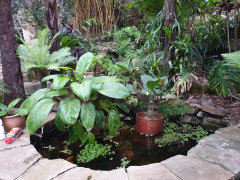
barbiekj1
3 years agoKit and Vera, Thank you for posting your challenges and recommendations for Medinilla. I am in Southern California and have had successes and failures similar to your experiences. I found your conversations and pictures to be very helpful, although we are in different climates. With temperatures at 40 F at night and dry windy temps 60-70 F daytime right now I have opted to bring my Magnificas and Myriantha inside and they are still challenged by low humidity, I believe, since reading this forum
and looking at your pictures. The plants seem to stress after a good watering. Maybe I let them dry out too much?Please keep sharing your experiences, this is the best information I have found on the internet.
barbiekj1
3 years agolast modified: 3 years agoKit and Vera, Thank you for posting your challenges and recommendations for Medinilla. I am in Southern California and have had successes and failures similar to your experiences. I found your conversations and pictures to be very helpful, although we are in different climates. With temperatures at 40 F at night and dry windy temps 60-70 F daytime right now I have opted to bring my Magnificas and Myriantha inside and they are still challenged by low humidity, I believe, since reading this forum
and looking at your pictures. The plants seem to stress after a good watering. Maybe I let them dry out too much?
Please keep sharing your experiences, this is the best information I have found on the internet.
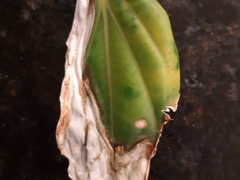
Vera Lynn
3 years agoHi Barbiekj1
It is pleasing indeed to think that someone even read our comments and delightful too think that they may have gained some benefit from our experience.
It is some time since I was in contact with Kit. Australia's horrendous bushfire season early last year, followed by the Covid 19 outbreak has caused many of us to become deeply engrossed in our own world. But our worries here in Australia seem very trivial compared with those currently facing the United States. As a keen gardener myself I am reinvigorated by the knowledge that despite the difficulties facing you, that you are still able to show some concern for your environment.
Jolting myself back to Medinilla, I am a little concerned about your need to move your Medinilla plants indoors. Some years back I wrote a book on the topic of growing Australian native plants indoor, as house plants. The most suitable plants to use indoors are generally those normally found growing in lower lit environments such as rainforests and jungles.
The problem is, that the two most critical environmental factors for plants are the two that are least well understood by most gardeners. Those factors are light and humidity.
Plants have a sensitivity to light which closely parallels our own sensitivity to temperature. A plant located close to a brightly lit window generally receives adequate light to maintain the production of essential sugars through the process of photosynthesis. But move that plant across the room and while we may hardly discern a change in light levels, the plant may be effectively have been moved into darkness. It may begin to shed lower leaves which, being now unable to receive sufficient light for photosynthesis have become redundant. At the same time, any new growth will probably be small and extended, with long stems between pairs of leaves as the plant stretches out to find more light. In the forest this would equate to an effort to reach the forest canopy where there is more light.
Artificial lighting is possible, but plants do best in light closer to the light blue or ultraviolet spectrum. The best we offer is usually cool fluorescent lighting. But even these lights need to be very close to the plants.
Of course it is important to keep the leaves free of dust which may impede what little light is available.
Humidity is the other commonly unappreciated factor. Humidity levels in the rainforest may be as high as 90% or more. In a temporate climate such as California, daytime levels usually average 40% to 60%. Even deserts are not devoid of atmospheric moisture. Deserts commonly have humidity levels of 10% to 35%. But in our built environment the humidity is usually between 10% and 20%. This is way too low for most of the plants we like to have indoors.
Short term measures such as keeping plants in a well lit bathroom, if not actually in the bath can help as will measures such as plant grouping and trays of moist gravel or similar.
As usual I have prattled on longer than was perhaps wise. But I did so with good intent and the hope that my words my contain a glimpse of something you find useful.
Regards,
Verakitskitchen
3 years agoHi Vera,
Nice to see you are commenting on Medinillas again. What a crazy year 2020 was, and 2021 hasn't totally changed yet, although it certainly is better here in Australia, as you mentioned too, than in a lot of places, particularly the USA. I hope you haven't been badly affected personally.
I moved my Medinella around to a shadier spot and am trying to give it maximum humidity by being over water again. I'm afraid that my version of a rain forest may not be enough though. It's got green leaves, but something has munched on them a bit - only a bit, but still. It's not putting out much growth, so I'll try some fertiliser - maybe orchid fertiliser "weakly and weekly." All suggestions welcome.
Thanks so much for your help,Kit
barbiekj1
3 years agoHi Vera, Thank you so much for your overview of Medinilla care! You gave me some general ideas on how to care for them inside my home.
Since writing you I have been paying closer attention to humidity and other problems with my plants. I am examining all three daily because recently I did find some Thrips under the leaves. They are relentless and it has been challenging trying to control them without harming the Medinillas, but I think I am closing in on success. Your words of experience and wisdom are valued and gave me hope to keep trying.
The Covid situation is tough and mostly because of social isolation. We are travelers and have adult children in other US locations. We look at the bright side every day and we hope for an end to this horrible virus so we all can get back to "normal".
Gardening has become almost an obsession to me and my world every day is my plants and cooking. Both have kept me busy and productive, there is never a dull moment.
I see that Kit has contacted you again and I am interested in her challenge. I will watch for any input from you.
Thank you again and keep the discussion going!
kitskitchen
3 years agoHi again, Vera,
If I may impose again, I'd like your good advice if you agree. My Medinilla was possibly too far into the water (about 10 cm of the fairly deep 40 cm pot) which I thought might help raise the humidity. Didn't seem to be good, so it's been completely out of the water, but still directly above it on a pile of bricks and tiles in a small artificial fish pond for a while. I don't think that's good either. It still looks unhappy, with no new leaves.
I'm wondering if a hanging basket (from a tree, so dappled but light shade) with orchid mix would work better for it. I have a couple of Stanhopea orchids that are quite happy that way. I'd have to water it regularly, I suppose, although this year the rains have been excellent here, so if that continues, perhaps it would be easy also.
Your advice if you are so inclined, would be much appreciated.
I do hope you are staying well and anxiety-free. We certainly have done well in Australia this year in controlling covid - and far fewer fires so far.
Best regards,Kit









Raymondo